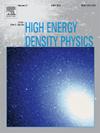Measurement of the impulse from a magnetic nozzle for the model experiment of laser fusion rocket
IF 0.9
3区 物理与天体物理
Q3 PHYSICS, FLUIDS & PLASMAS
引用次数: 0
Abstract
Magnetic nozzle is a component of a propulsion system which obtain thrust from a plasma in a magnetic field. Previous works have investigated the plasma behavior and thrust performance of the magnetic nozzle through experiment and simulation. A thrust stand with a pendulum has been used to experimentally evaluate the impulse bit generated by magnetic nozzle. A direct method, which measures the impulse bit on the magnet by putting it on the pendulum, may be difficult to measure the displacement because of the vibration. An indirect (target) method, which measures the impulse of the plasma accelerated by the magnetic nozzle, can be applied for large pulsed-electromagnets, but may be difficult to measure all of the impulse because of the limited detectable area. Here, we performed two impulse bit measurements with pendulum methods for the same magnetic nozzle. Also, we measured ion current at the same position of the target measurement to investigate the ion extraction from the nozzle. Although the obtained impulse bits are different, the target measurement reproduced the similar energy dependence as the simulation results. In addition, the spatial distribution of ions discharged downstream of the magnetic nozzle could be obtained by ion measurement. Combining these results suggests the possibility of evaluating impulses by target measurement in the future.
激光聚变火箭模型实验磁喷管冲量的测量
磁喷嘴是一种从磁场中的等离子体中获得推力的推进系统部件。以往的工作通过实验和仿真研究了磁喷嘴的等离子体行为和推力性能。利用带摆的推力台对磁喷嘴产生的冲击钻头进行了实验评价。将磁体置于摆锤上,直接测量磁体上的脉冲位,由于振动的原因,可能难以测量位移。测量磁喷嘴加速等离子体的脉冲的间接(靶)方法可用于大型脉冲电磁铁,但由于可探测区域有限,可能难以测量所有的脉冲。在这里,我们使用摆锤方法对同一个磁喷嘴进行了两次脉冲钻头测量。此外,我们还在目标测量的同一位置测量了离子电流,以研究从喷嘴中提取离子的情况。虽然得到的脉冲比特不同,但目标测量再现了与仿真结果相似的能量依赖关系。此外,还可以通过离子测量获得磁喷嘴下游放电离子的空间分布。结合这些结果,提出了未来通过目标测量来评估脉冲的可能性。
本文章由计算机程序翻译,如有差异,请以英文原文为准。
求助全文
约1分钟内获得全文
求助全文
来源期刊

High Energy Density Physics
PHYSICS, FLUIDS & PLASMAS-
CiteScore
4.20
自引率
6.20%
发文量
13
审稿时长
6-12 weeks
期刊介绍:
High Energy Density Physics is an international journal covering original experimental and related theoretical work studying the physics of matter and radiation under extreme conditions. ''High energy density'' is understood to be an energy density exceeding about 1011 J/m3. The editors and the publisher are committed to provide this fast-growing community with a dedicated high quality channel to distribute their original findings.
Papers suitable for publication in this journal cover topics in both the warm and hot dense matter regimes, such as laboratory studies relevant to non-LTE kinetics at extreme conditions, planetary interiors, astrophysical phenomena, inertial fusion and includes studies of, for example, material properties and both stable and unstable hydrodynamics. Developments in associated theoretical areas, for example the modelling of strongly coupled, partially degenerate and relativistic plasmas, are also covered.
 求助内容:
求助内容: 应助结果提醒方式:
应助结果提醒方式:


